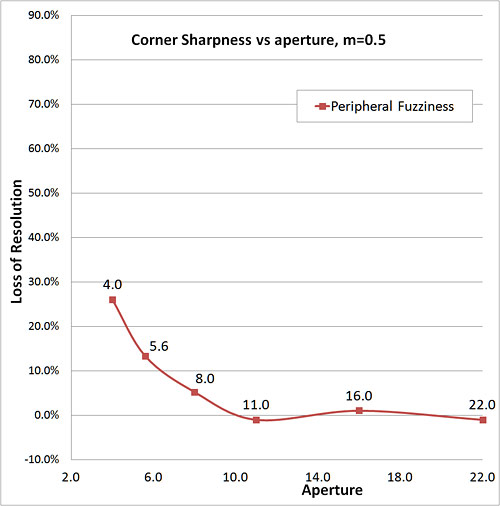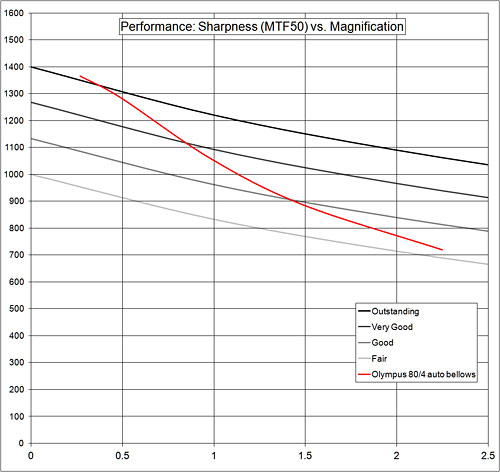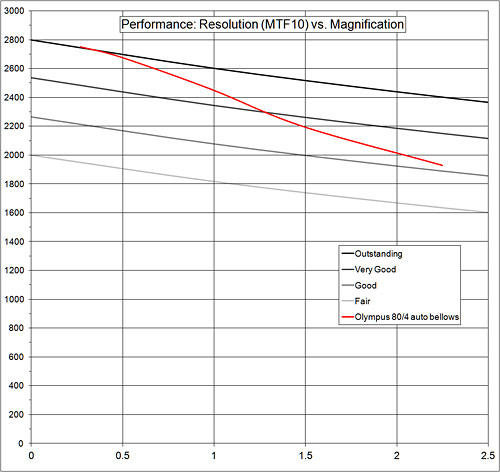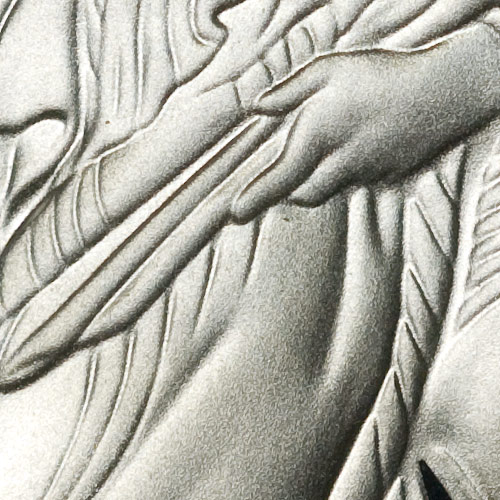Lens: Olympus 80mm f/4 auto bellows
Vintage: 1980-??
Lens Mount: Olympus OM mount.
Needed Adapters: To make this lens work on a non-Olympus lens mount, you will need a couple different adapters. First, I use an OM to 4/3 adapter. That will allow one to use an OM lens on new Olympus 4/3 mount dSLR's. Second, I use cheap (5-piece) extension tubes from eBay. These have screw-on lens mounts on the front and back. If you buy one for a 4/3 mount and one for your camera's lens mount, you can take the female 4/3 mount and screw that to the male lens mount for your camera. hook them all together and you are ready to go. The only problem is that some of the cheap extensions have the opposite threading and you may end up both pieces having a male thread. I would suggest that you buy them from the same supplier (and keep your fingers crossed). If that happens, all is not lost. I have found a 57mm step-down ring that will fit into the female adapter and that can be adapted to a reversing ring (I had to do this to make a Minolta adapter, so I know it works).
Preferred Mounting: Normal, not reversed.
Filter Thread: 49 mm.
Street Price: $100-$150 in good used condition. Prices vary a lot online, shop around.
Controls: Aperture setting. There is also a focus adjustment that gives some fine comtrol of extension.
Aperture: 6 blades.
Basic Function: Requires a bellows to set focus and magnification
| Extension | Magnification | Working Distance |
| 25 mm | 0.27 | 345 mm |
| 5 cm | 0.49 | 211 mm |
| 9 cm | 0.98 | 126 mm |
| 13 cm | 1.48 | 98 mm |
| 19 cm | 2.25 | 80 mm |
| Est. Focal Length: 79.8 mm | ||
Appearance:


 Resolution vs. Aperture:
Resolution vs. Aperture:
This lens is at its sharpest at f/5.6. For the focal length, this is a typical sharpest aperture.
The most detailed aperture is also f/5.6.
 Corner Sharpness vs. Aperture:
Corner Sharpness vs. Aperture:
Fuzziness in the corners is good at f/4 and f/5.6 and very good above that. This is as good as most modern macro lenses.
Testing was performed at the 0.5:1.
 Sharpness and Resolution vs. Magnification:
Sharpness and Resolution vs. Magnification:
This lens produces performance that is comparable to modern macro lenses below 1:1 Above 1:1, the performance is good but can be outdone by shorter focal length lenses.
The corner sharpness is good to very good across the magnification range. The lens seems to be optimized to about 1:1 for the corner performance.
 Performance: Sharpness vs. Magnification:
Performance: Sharpness vs. Magnification:
I have 4 lines that represent levels of performance from outstanding (top) to fair (bottom). This shows where this lens fits into the hierarchy that I have created.
The Olympus 80 mm shows sharpness performance that varies from very good to outstanding below 1:1 to fair to good above 1:1.
 Performance: Resolution vs. Magnification:
Performance: Resolution vs. Magnification:
I have 4 lines that represent levels of performance from outstanding (top) to fair (bottom). This shows where this lens fits into the hierarchy that I have created.
The Olympus 80 mm shows resolution performance that varies from very good to outstanding below 1:1 to good to very good above 1:1.
 Resolving Power vs. Magnification:
Resolving Power vs. Magnification:
This graph represents the smallest details that are able to be resolved by this lens at various magnificaitons. If the number doesn't get smaller as the magnification rises, there is little benefit to going up in magnificaiton with this lens. This situation is also called empty magnification.
Very good resolution, no problems.
 Chromatic Aberration:
Chromatic Aberration:
This lens show minimal color fringing in the center (about 0.02 - 0.40 pixel), worst at the upper magnification range. It shows minimal/moderate fringing on the periphery (0.003 - 0.090%), best at 1:2. Anything below 0.04% is not considered significant. The mild to moderately visible fringe is only seen when used above 1:1. There is mild axial CA on out-of focus details (see image below) as shown by a slight red fringe on the right and a slight green/cyan fringe on the left of the image.
Longitudinal CA:

Image Contrast: Image contrast is very good, typical for high-quality bellows lenses.
Flare: This lens shows no significant flare during testing.
Distortion: This lens shows no significant distortion during testing.
Image Samples:
About 0.5:1 magnification, f/5.6, cropped and resized:

 Pixel level crop from the image above:
Pixel level crop from the image above:
There is very good pixel level detail, no problems.
About 1.5:1 magnification, f/5.6, stack of 6 images, resized:

 Pixel level crop from the image above:
Pixel level crop from the image above:
There is good pixel level detail, no problems.
Conclusion:
This is a bellows lens that performs very well compared to modern macro lenses and has the benefit of going to above 2:1 magnification on a bellows. The sharpness and resolution are comparable to modern macro lenses in the same focal length range below 1:1. The field flatness is very good and seems to be optimized for 1:1 The chromatic aberration is minimal to moderate on the periphery and seems to optimized for about 0.5:1. The mild to moderate fringes are seen above 1:1. The contrast is good, typical for a macro lens.
Overall this bellows lens performs well, comparable to modern macro lens offerings. The real draw of this lens is its price, typically around $100 - $150 used, much less than a modern macro lens although you will also need to purchase a bellows. This lens has an OM mount that can be a little difficult to adapt to other lens mounts. It should be a good lens for most macro work from 1:4 to a little above 2:1.